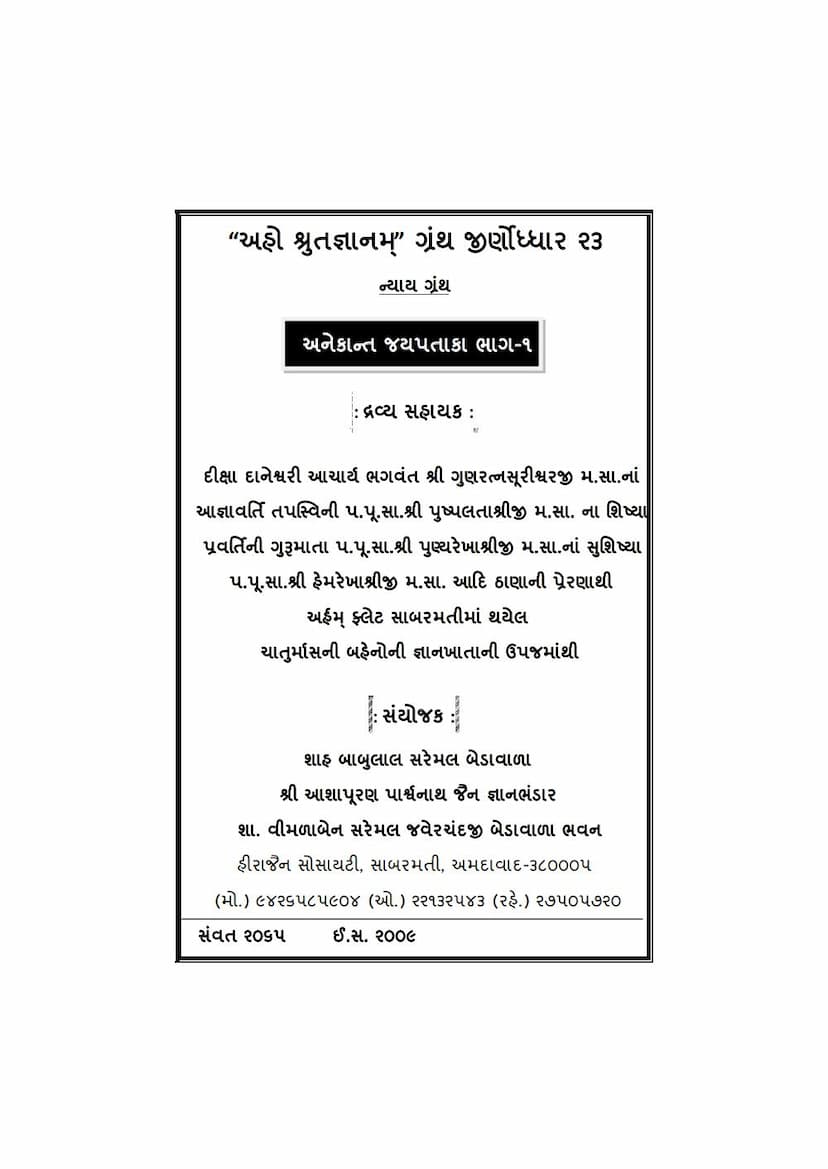Anekantajay Patakakhyam Prakaranam Part 1
Added to library: September 1, 2025

Summary
Here's a comprehensive summary of the provided Jain text, "Anekantajayapatakakhyam Prakaranam Part 1," based on the pages you've shared:
Title: The text is titled Anekāntajayapatākā Prakaraṇa. The title itself signifies a treatise that is a "banner of victory for the doctrine of Anekānta" (many-sidedness). The author, Haribhadra Sūri, is believed to have chosen this title to emphasize that his work refutes criticisms against Anekāntavāda, particularly those from the Bauddhas and others, thereby establishing its supremacy over Ekāntavāda (one-sided exposition). The word "Prakaraṇa" in the title indicates a small treatise focused on a particular subject.
Author: The primary author is Haribhadra Sūri, a renowned Jain scholar known for his erudition and impartial attitude. He is believed to have been a Svetambara Jain who belonged to the Vidyadhara kula. His dikṣāguru was Jinadatta Sūri, and Yakini Mahattara was his dharmajananī (god-mother). His date is estimated to be around the 7th century AD, though some scholars suggest as late as the 10th century AD based on certain references. Haribhadra Sūri was a prolific writer, with attributions ranging from 1400 to 1444 works, covering original texts and commentaries on canonical literature.
Commentaries: The text is presented with two commentaries:
- Haribhadra Sūri's own commentary (Svopajña Vṛtti): This is the author's explanation of his own work.
- Municandra Sūri's supercommentary (Tippaṇaka): Municandra Sūri was a disciple of Vädin Deva Sūri and flourished around the 12th century AD. His supercommentary provides further clarification on the text and Haribhadra Sūri's commentary, particularly on difficult or intricate points.
Publisher and Series: The work is published as part of Gaekwad's Oriental Series by the Oriental Institute, Baroda, under the authority of the Government of His Highness the Maharaja Gaekwad of Baroda. This series is recognized for its high scholarly standards and aims to publish critical editions of important Oriental literary works.
Content and Structure:
- Subject Matter: The book is a philosophical treatise that delves into the doctrine of Anekāntavāda (the doctrine of many-sidedness). It aims to refute one-sided doctrines (Ekāntavāda) and establish the victory of the many-sided perspective. The introduction highlights that Anekāntavāda's sphere is unlimited, encompassing epistemological, metaphysical, and ethical discussions.
- Organization: The text is divided into Adhikāras (sections). The introduction mentions that the author calls them adhikāras. While the exact titles of all sections are not provided in the introduction, the content suggests they deal with:
- The existence and non-existence of an object from different angles.
- Its permanence and impermanence.
- Its generality and speciality.
- Its describability and non-describability.
- An exposition and refutation of Yogācāra.
- The doctrine of liberation.
- Language: The text is primarily written in classical Sanskrit.
- Style: The style is described as lucid, concise, clear, argumentative, dignified, and refined, reminiscent of works like Sankarābhāṣya. The text begins with 10 verses in Āryā meter, including a mangalācaraṇa (auspicious invocation), and concludes with 10 verses in Āryā. The rest of the text is in prose, interspersed with verse quotations.
Key Themes and Concepts from the Introduction:
- Anekāntavāda (Many-sidedness): This is the central theme. It's defined as a "many-sided exposition," considering all possible angles of vision regarding an object or idea. It's contrasted with Ekāntavāda (one-sided exposition) and is also referred to as Syādvāda.
- Syādvāda: While some scholars distinguish between Anekāntavāda and Syādvāda, the introduction argues that historical Jain authors considered them synonyms. Syādvāda is characterized by statements like "Syādasti" (in a certain way it exists), acknowledging conditional existence and multiplicity of views.
- Refutation of Opposing Views: The work is intended to refute the one-sided views of opponents, particularly the Bauddhas, and establish the superiority of Anekāntavāda.
- Importance of the Doctrine: Anekāntavāda is considered fundamental to understanding the world and reality, guiding both metaphysical and ethical aspects of life.
Editorial Information: The critical edition was undertaken by H. R. Kāpaḍīā, M.A., Lecturer in Ardhamāgadhī, M.T.B. College, Surat, and formerly Post-graduate Lecturer at the Bhandarkar Oriental Research Institute, Poona. The printing was a lengthy process due to the intricate nature of presenting the text and its two commentaries on the same page, along with footnotes. The work was issued in two volumes.
In essence, this volume is a scholarly critical edition of Haribhadra Sūri's foundational work on Anekāntavāda, meticulously edited and presented with its commentaries to facilitate a deeper understanding of this core Jain philosophical principle.